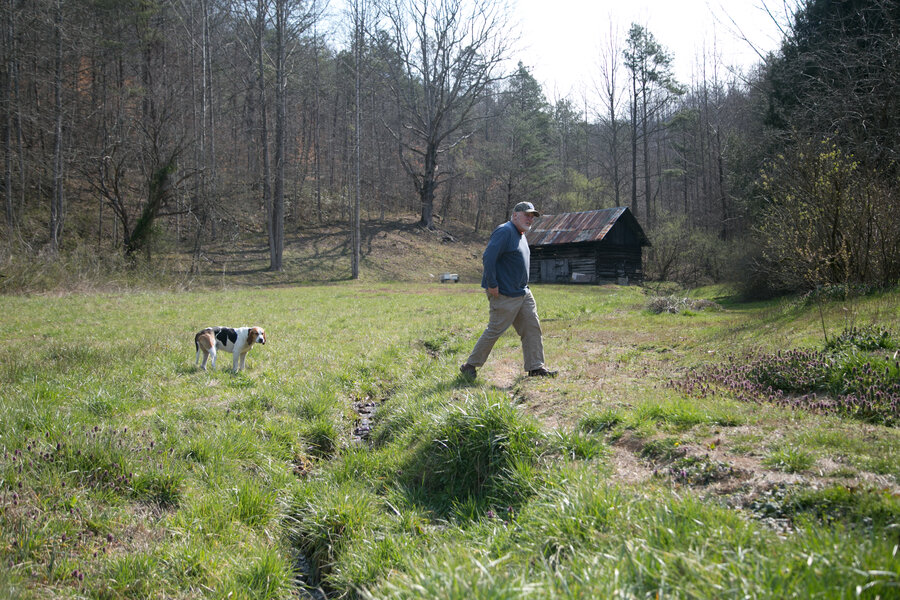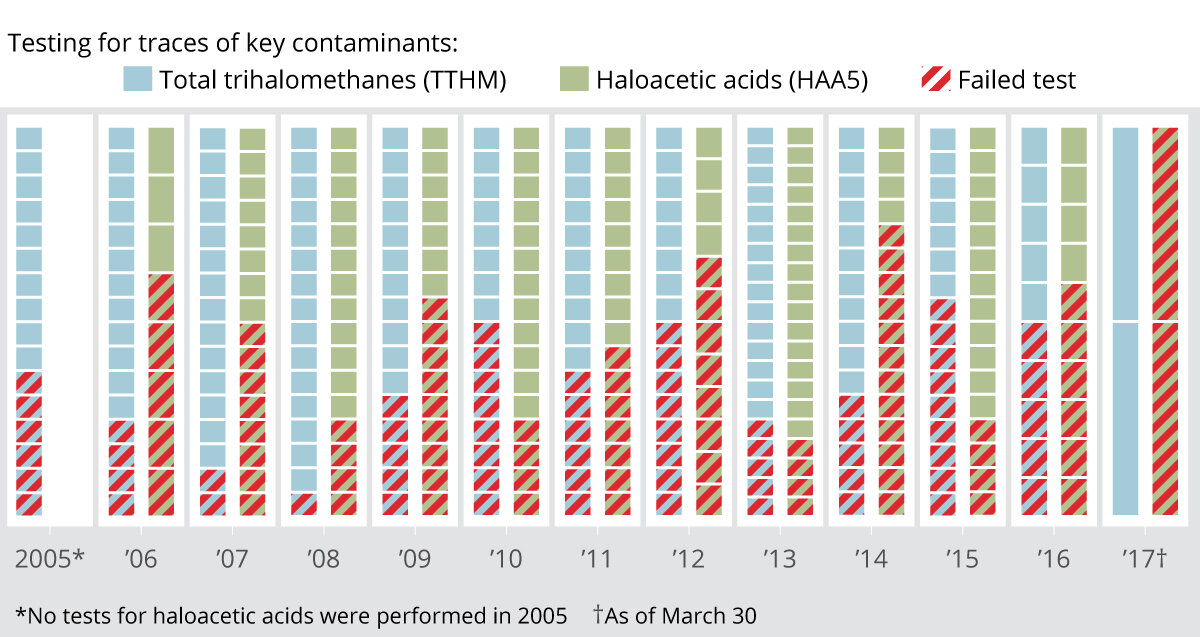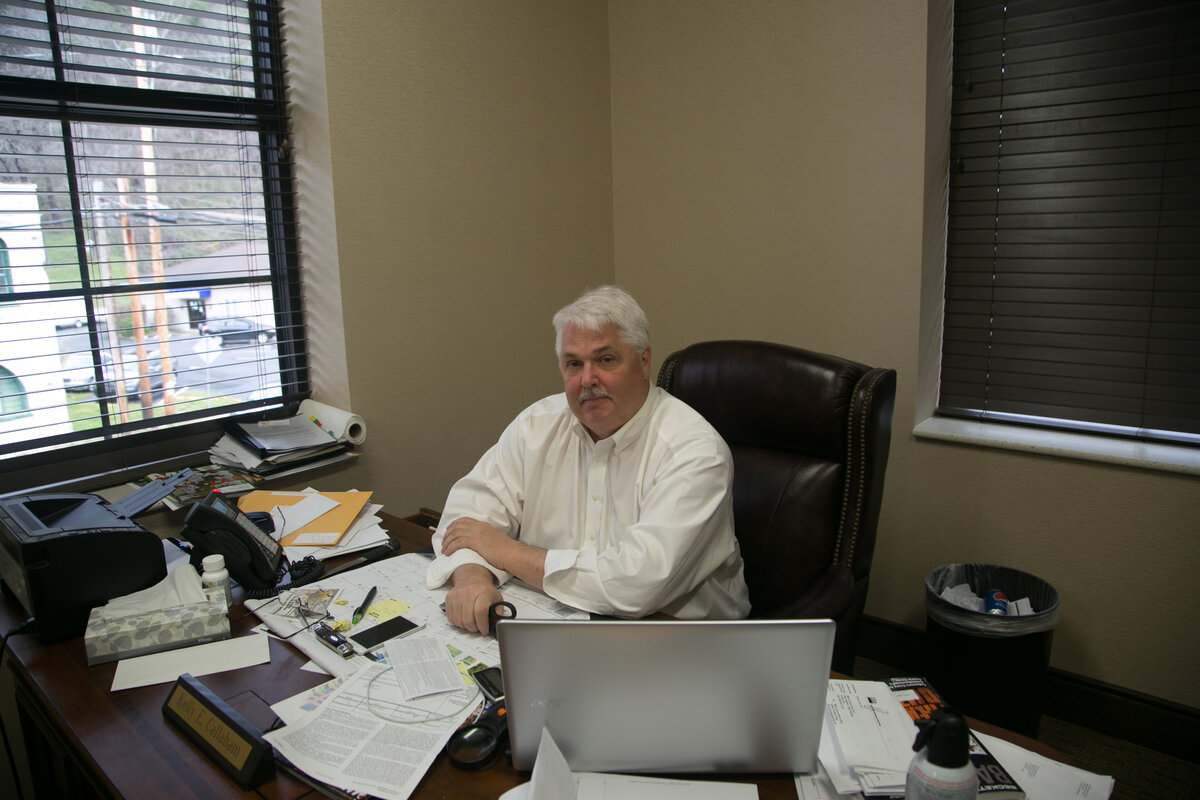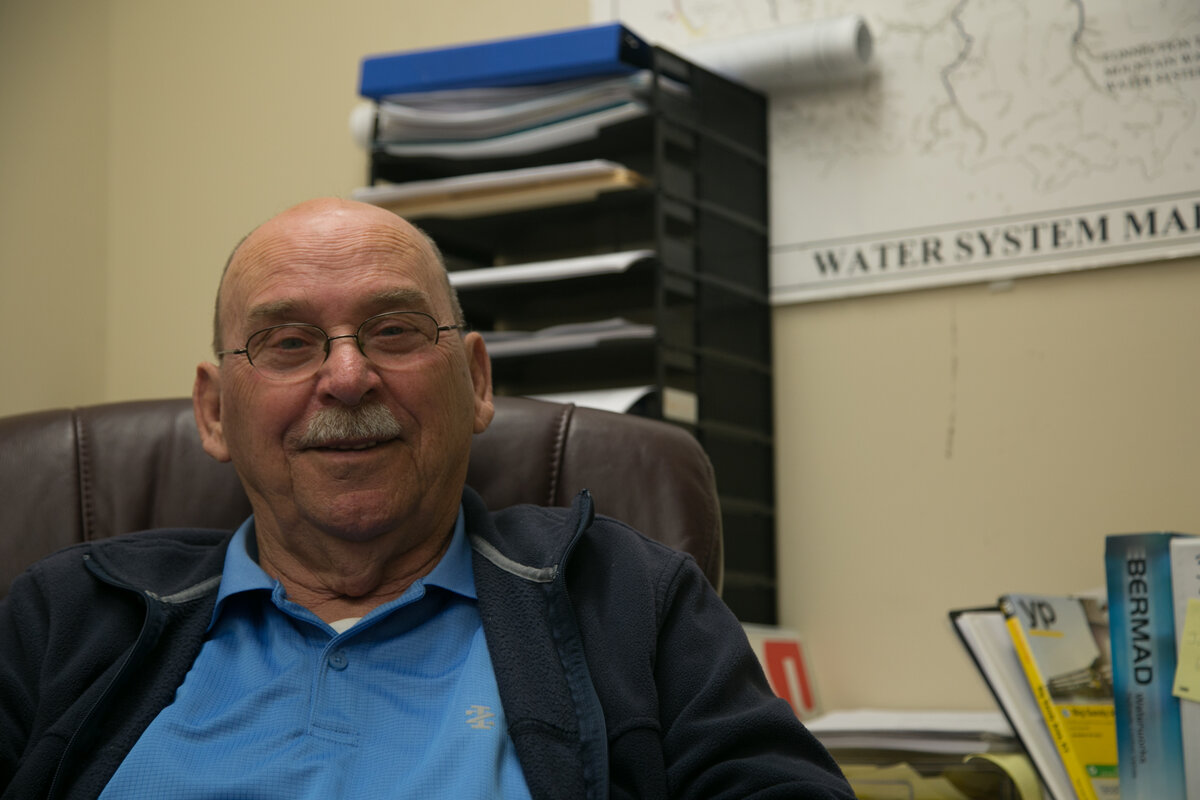The place in America where (almost) no one drinks their tap water
Loading...
| Inez and Tomahawk, Ky.
T.J. Fannin, sitting on his porch as the sun sets, speaks fondly of the 27 years he spent working in nearby coal mines. But despite the hard labor that fueled a coal boom and sent millions of dollars into Kentucky’s coffers, he says he and his neighbors lack a basic amenity: clean tap water.
“[O]n the TV you see someone go to the faucet and get a drink of water, and it just makes me mad cause, you know, we can’t do that,” says Mr. Fannin, who buys two or three 24-packs of bottled water a month for drinking and cooking. “There’s an odor to the water…. It’s just like stagnant water [that] comes out of the bottom of a pool.”
It’s no secret that the decline of coal has hit the mountain spine of Appalachia hard. But it's less well known that an amenity of life most Americans take for granted isn’t a given, more than 50 years after Lyndon B. Johnson launched his “war on poverty” here in Martin County, Ky.
And what really gets Fannin’s goat, he says, is that residents here face far higher water bills than in nearby counties. This, despite frequent warnings that the local water has exceeded Environmental Protection Agency (EPA) limits for certain chemicals.
“We should have a top-notch water system, septic system, schools, roads,” given all the proceeds from coal mining over the years, says the former miner. “We got this 4-lane [highway] down here and that’s basically all we got.”
In a place where political distrust runs high and funds are scarce, little has been done to improve the county’s water quality or infrastructure, as reported by the Ohio Valley Resource's Benny Becker in January.
Local officials argue that the water issue has been blown out of proportion by a handful of outspoken residents, whose activism sends the water district jumping through bureaucratic hoops instead of fixing a creaking system. For the rest of the community, relying solely on bottled water is seen as just a way of life, not a reason to protest.
Two students hanging out in the high school parking lot say their parents have always had a family rule against drinking from the tap. Becky, a grocery cashier in nearby Warfield, says she hasn’t consumed the county’s water since 1999. Neither a hardware-store owner nor a retired butcher can remember the last time they drank from the tap.
“There is a fundamental breakdown in the expectation of democracy in places like Appalachia,” says Alexander Gibson, director of Appalshop, a media organization in Whitesburg, Ky. “They have observed that a complaint to the government disappears like the morning fog.”
Exceeded EPA limits repeatedly since 2005
In the bowels of the Martin County Water District offices, Joe Hammond sits in front of an Excel sheet, a map of the county’s water lines taped on the wall above him.
Piles of paper teeter beside his elbows, while packs of bottled water are stacked next to the filing cabinets. He says the girls in the office drink that, not him. As far as he’s concerned, the local water is fine.
“I raised two fine young children with that water,” says Mr. Hammond, the supervisor of the water district.
But Lee Mueller, who was also born here, became concerned about the water when he moved back in the 1980s.
“I had written stories about it for years,” says Mr. Mueller, who served as the Lexington-Herald Leader’s eastern Kentucky bureau chief for three decades. He blames the water quality for his own cancer diagnosis. “I didn’t really get involved with water until we were getting notices of violation that were two months old from the water district that they were required by law to inform residents that they had exceeded contaminant levels for various cancer-causing agents.”
According to Kentucky Division of Water records, Martin County’s water system has exceeded EPA limits for certain chemicals in its drinking water multiple times every year since 2005. Martin County was out of compliance in eight of the last 10 tests for haloacetic acid (HAA5) limits and 6 of the last 10 tests for total trihalomethanes (TTHM) limits.
These chemicals – by-products of chlorine treatment intended to make the water palatable – aren’t considered as dangerous as the lead that laced Flint’s water in Michigan. But the notifications sent to residents by the water district warn that extended exposure increases the risk of cancer.
Gail Brion, an engineering professor at the University of Kentucky who previously worked for the EPA, says the agency sets conservative limits for HAA5s and TTHMs. But an ethical controversy arises, says Professor Brion, when the government gives you no choice but to pay for bottled water in order to avoid this health risk.
Funding and priorities
The highest elected official in Martin County, Judge Executive Kelly Callaham, can be found in his corner office in the county’s newest courthouse. When asked about his county’s water quality, Judge Callaham leans forward in his chair and waves one hand in the air.
“You could drink four gallons of our water every day for 70 years and you have a chance of getting cancer. Well, hell, if you eat hot dogs, read what’s in hot dogs. You could eat four hot dogs a day for 70 years and you probably wouldn’t last 70 years,” says Callaham. “ ‘Could cause cancer,’ and ‘will cause cancer’ is a whole different deal.”
Callaham blames the EPA-mandated notices and the local newspaper, the Mountain Citizen, for what he considers unnecessary hysteria.
Editor Gary Ball has published a steady stream of articles on the water issue, as well as Callaham’s alleged misuse of county finances, including the $10 million courthouse building. “The system has been mismanaged for years,” Mr. Ball says.
Kentucky began issuing a “severance” tax on coal companies in 1972 to assist economic development. According to state records obtained by the Monitor, out of $34.5 million in coal severance funds disbursed since 2001, Martin County spent $7.3 million – or about 21 percent – on sewer and water improvements.
Comparatively, state Senator Ray Jones – who represents five counties including Martin County – says his home of Pike County spent 70 to 75 percent of its severance tax funds on water and sewer infrastructure.
“A lot of it comes down to funding,” says Senator Jones, “but a lot of it comes down to priorities.”
Among other projects, Martin County spent about $3.3 million in coal severance funds on the new courthouse, and another $7 million to build the Inez Business Center. Local critics say these funds could have made a big dent in repairing Martin County’s water system, with estimates of total renovation running between $13 and $15 million.
Coal severance revenues have plummeted in recent years. In 2016, Martin County received only 12 percent of what it got in 2009. Today the revenues provide just enough to cover the bond payments on the new courthouse.
Callaham says he wouldn’t have built it if he knew the coal severance money was going to run out so quickly.
But Darren Sammons with the Kentucky Department of Local Government says, “[W]e have been advising local officials for years to expect lower coal severance revenues and to budget accordingly.”
A system built for 600, serving 3,500
Meanwhile, Hammond is left to address the water district’s manifold problems as best he can.
Martin County’s water system – including a treatment plant – was built in 1968 for 600 customers. It currently serves 3,500. This expansion of lines in eastern Kentucky’s rocky hills created an underground system susceptible to holes and line breaks – and therefore water loss.
The EPA estimates the average water loss in the US to be 15 percent per month, but Martin County has been under investigation by the Kentucky Public Service Commission (PSC) in recent years for water loss rates greater than 60 percent.
When there’s a problem, Martin County residents often call the local newspaper instead of the water district, circumventing Hammond.
The newspaper goes directly to the PSC, which responds to the paper’s complaints by issuing Hammond extensive paperwork, which he says diverts resources away from dealing with customers’ problems.
“I’m still working on things they have asked for” – back in June 2016, he says.
'People are afraid to complain'
A Facebook group called Martin County Water Warriors, which has more than 1,000 members, regularly posts updates on water quality issues – everything from photos of corroded water heaters to updates about the next hearing on Martin County's water (June 1 in Frankfort, Ky.).
Nina and Mickey McCoy, longtime environmental activists, say they have also tried to organize citizen meetings to demand action on the city’s water quality, but with little effect. Once, they ordered dozens of pizzas and not a single person showed up.
In a place where Big Coal holds so much sway, few are willing to publicly share their grievances.
“People are afraid to complain about the water,” says Mr. McCoy, because they fear losing their jobs or severance packages. “Or their third cousin might be fired. It runs deep.”
There’s also a pervasive feeling that speaking up won’t accomplish anything.
“The government just doesn’t seem to work on this level for the people,” says Dan Preece, a world history teacher at Sheldon Clark High School – who is willing to speak on the record only because he is tenured.
“When the kids see over time what does get spent here ... you see a new courthouse built, but we can’t get the water fixed,” says Mr. Preece. “They don’t feel like they matter, like this is not a problem worth solving.”
But Jones, for one, is working on solving it.
“It needs to be a collaborative effort between local officials, local citizens, and state officials,” says Jones, who in February introduced legislation to give the PSC greater leverage over water districts. “It’s not going to be resolved overnight… but there needs to be a plan.”
Staff writer Christa Case Bryant contributed reporting.










